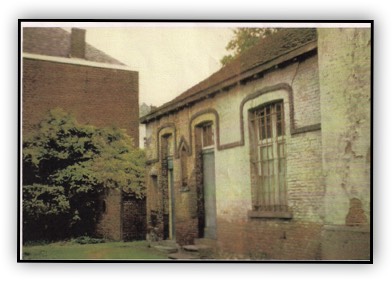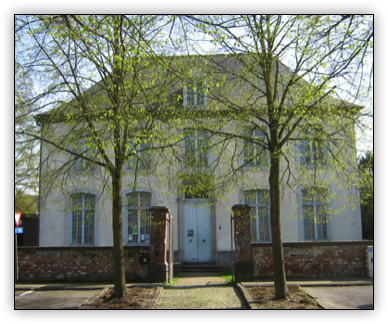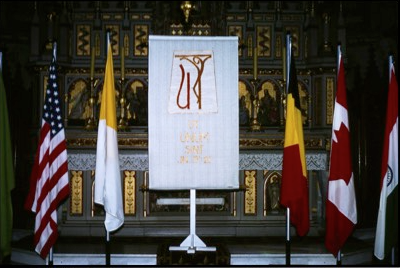
“I have come so that they may have life and have it to the full” John 10:10
The Ursuline Sisters Congregation of Tildonk
In the beginning of the 19th century several Congregations tried to open up schools, but these were mostly in the cities and only for boys and for the rich.
Our founder Pastor John Lambertz saw the need for educating girls, who during that period, had no means of education, literacy, or catechesis. He deeply longed to do something for them. He talked about this with other priests, prayed much and offered penance for this intention and God answered him.
Our founder Pastor John Lambertz saw the need for educating girls, who during that period, had no means of education, literacy, or catechesis. He deeply longed to do something for them. He talked about this with other priests, prayed much and offered penance for this intention and God answered him.

The stable where the Pastor John Lambertz began the school
One day, a young lady, Anna-Marie Van Groederbeek, then 26 years of age, was sent by her Confessor to Father Lambertz. She spoke to him about her wish to enter a convent, but since she did not speak French, she could not be accepted in any Convent. She proposed to help the Pastor begin a school.
The Pastor’s servant, Maria Van Ackerbroeck, 27 years old, had often spoken about her desire to become a nun. She could help with household chores and the two could live together a sort of religious life. When another young lady who lived in Tildonk, Catharina Van den Schriek, 26 years of age, heard of this initiative, she asked to join the other two.
On April 30, 1818, on the feast of the Ascension of Our Lord, the three young women were accompanied by their own mothers to the parish. They began a ten-day retreat under the guidance of Pastor Lambertz and on Pentecost Day they offered themselves to the Lord.
The Pastor’s servant, Maria Van Ackerbroeck, 27 years old, had often spoken about her desire to become a nun. She could help with household chores and the two could live together a sort of religious life. When another young lady who lived in Tildonk, Catharina Van den Schriek, 26 years of age, heard of this initiative, she asked to join the other two.
On April 30, 1818, on the feast of the Ascension of Our Lord, the three young women were accompanied by their own mothers to the parish. They began a ten-day retreat under the guidance of Pastor Lambertz and on Pentecost Day they offered themselves to the Lord.
The Parish house - presbytery of Tildonk Parish

They lived in the parish house as religious, and their pastor named them
“Daughters of Saint Ursula”.

Convent Church in Tildonk
This is how our Congregation began. On March 20, 1823, the eve of the feast of Our lady of Sorrows, the Pastor received permission from King William of Holland to continue building the school and the chapel. Earlier King William had asked the pastor to stop the building and send the sisters away to their homes, to continue building the school and the chapel. He further gave permission to reassemble the sisters as a lay association. On March 4, 1825, twelve Sisters pronounced their first vows. On March 13th the first superior was elected. On May 1st, 1832, the Rule of Saint Augustine and the Constitutions of the Ursuline Sisters of Bordeaux, modified and adapted according to the times and local needs by the Bishop, Monsignor Sterckx, and the Pastor, were accepted by the Sisters. On the same day, eighteen of them pronounced their final vows in Tildonk.
Now that the Congregation of the Ursuline Sisters of Tildonk had been accepted, the Pastor could send the Sisters to other parishes where priests desired to open schools for the education of girls. Since the beginning of his priesthood, the Pastor cared for the Christian formation of youth. He was eager to advocate for the education of girls, letting GOD be known by them and loved by children. Did not St. Angela do the same thing?
From 1832 on, after the Independence of Belgium, Pastor Lambertz founded many convents, not only in Belgium, but also in the Netherlands and in Germany. From there the Sisters went to South Africa and Indonesia. In 35 years, 42 convents were founded.
From 1832 on, after the Independence of Belgium, Pastor Lambertz founded many convents, not only in Belgium, but also in the Netherlands and in Germany. From there the Sisters went to South Africa and Indonesia. In 35 years, 42 convents were founded.

Later, several houses that were founded by Pastor Lambertz chose to join the Roman Union.
This happened in the Netherlands with Venray, Sittard, Uden, Posterholt, Grubbenvorst, Breust-Eisden, Roermond, Kerkrade, Maastricht and Echt. They can be considered as the basis for the Dutch Province of the Roman Union.
In a similar way, the Belgian, English, Indonesian and South African Provinces of the Roman Union were born.
This happened in the Netherlands with Venray, Sittard, Uden, Posterholt, Grubbenvorst, Breust-Eisden, Roermond, Kerkrade, Maastricht and Echt. They can be considered as the basis for the Dutch Province of the Roman Union.
In a similar way, the Belgian, English, Indonesian and South African Provinces of the Roman Union were born.

The Sisters were sent from Tildonk to London in 1851. After many difficulties they purchased a house in Upton where they built the foundation of the Province of the Roman Union in England.
In 1855, the Pastor sent five Sisters from Sittard and Maaseik to Batavia. One of them died just after her arrival. Two years later, a group of nine Sisters was added. These Sisters came from six different Convents in Belgium and the Netherlands. This was the beginning of the Indonesian Province of the Roman Union.
Almost 30 years after the death of Pastor Lambertz in 1895, five Sisters from Sittard and one from Upton began a mission in Transvaal. Therefore, two houses founded by the Pastor gave life to the Roman Union Province of South Africa. And in 1905 the house of Zaventhem joined the Belgian Province of the Roman Union.The Ursulines of Tildonk have, therefore, contributed to forming a big family of Ursulines.
The Sisters of the Ursuline Convent in Tildonk also showed their love and openness by heartily welcoming different groups of French refugees. In 1901, 112 years after the French Revolution, the French Parliament voted a ‘Law of Association’ which gave the signal for persecuting religious and priests. The Sisters were thrown out of their houses, and their properties were confiscated, after the closing of their institutions.
The first four Sisters who arrived in Tildonk in August 1901 came from Nuits St. George in France and in October and November, three other Sisters arrived from the same convent belonging to the Congregation of Paris.
In 1904 new groups of Sisters came as refugees: on July 25th nine Ursulines from Caen, on August 6th seven Ursulines from Quintin, on August 24th, seven Ursulines from Tulle, on December 24th an Ursuline from Havre. Several years later an Ursuline from Auch, a city in France, came.
In 1903 four Sisters from Tildonk left for Ranchi in India, at that time, Bengal State. Now there are more than 805 Sisters in 90 Convents in India.
In 1914 they sailed for Canada, and in 1924 they went to the United States. At present there we are six sisters in Canada and 37 Sisters in the US Province.
In 1955 the first Ursulines from Tildonk arrived in Zaire, now the Democratic Republic of Congo. This was five years before the colony became independent. There are 68 Sisters in DR Congo at present.
In 2006 the Tildonk Ursulines began a mission in Guyana, South America, with four sisters presently ministering there.
Since 1978 the Congregation of Tildonk has had an International Congregational Government, composed of members from the various Provinces. With a view to fostering the internationality of the Congregation, the 1978 General Chapter mandated the General Government to apply for Pontifical Status, which was granted on October 18, 1982.
Our General Constitutions and Directives, "Fullness in the Life of Christ," were approved on September 15, 1983, the feast of Our Lady of Sorrows. Inspired by the life and charism of Angela Merici, foundress of the Ursuline tradition and of our founder, John Lambertz, we are committed to the mission of the universal Church.
Our specific mission is to make God known and loved by responding to the needs of the local Church wherever we are. To meet these needs, our Congregation accepts a diversity of ministries while it gives priority to education in its broadest sense. The 1996 General Chapter mandated that the Indian Province be divided because of the large number of Sisters and great distances between houses. Thus, three provinces and a district were created in 1997.
In 1855, the Pastor sent five Sisters from Sittard and Maaseik to Batavia. One of them died just after her arrival. Two years later, a group of nine Sisters was added. These Sisters came from six different Convents in Belgium and the Netherlands. This was the beginning of the Indonesian Province of the Roman Union.
Almost 30 years after the death of Pastor Lambertz in 1895, five Sisters from Sittard and one from Upton began a mission in Transvaal. Therefore, two houses founded by the Pastor gave life to the Roman Union Province of South Africa. And in 1905 the house of Zaventhem joined the Belgian Province of the Roman Union.The Ursulines of Tildonk have, therefore, contributed to forming a big family of Ursulines.
The Sisters of the Ursuline Convent in Tildonk also showed their love and openness by heartily welcoming different groups of French refugees. In 1901, 112 years after the French Revolution, the French Parliament voted a ‘Law of Association’ which gave the signal for persecuting religious and priests. The Sisters were thrown out of their houses, and their properties were confiscated, after the closing of their institutions.
The first four Sisters who arrived in Tildonk in August 1901 came from Nuits St. George in France and in October and November, three other Sisters arrived from the same convent belonging to the Congregation of Paris.
In 1904 new groups of Sisters came as refugees: on July 25th nine Ursulines from Caen, on August 6th seven Ursulines from Quintin, on August 24th, seven Ursulines from Tulle, on December 24th an Ursuline from Havre. Several years later an Ursuline from Auch, a city in France, came.
In 1903 four Sisters from Tildonk left for Ranchi in India, at that time, Bengal State. Now there are more than 805 Sisters in 90 Convents in India.
In 1914 they sailed for Canada, and in 1924 they went to the United States. At present there we are six sisters in Canada and 37 Sisters in the US Province.
In 1955 the first Ursulines from Tildonk arrived in Zaire, now the Democratic Republic of Congo. This was five years before the colony became independent. There are 68 Sisters in DR Congo at present.
In 2006 the Tildonk Ursulines began a mission in Guyana, South America, with four sisters presently ministering there.
Since 1978 the Congregation of Tildonk has had an International Congregational Government, composed of members from the various Provinces. With a view to fostering the internationality of the Congregation, the 1978 General Chapter mandated the General Government to apply for Pontifical Status, which was granted on October 18, 1982.
Our General Constitutions and Directives, "Fullness in the Life of Christ," were approved on September 15, 1983, the feast of Our Lady of Sorrows. Inspired by the life and charism of Angela Merici, foundress of the Ursuline tradition and of our founder, John Lambertz, we are committed to the mission of the universal Church.
Our specific mission is to make God known and loved by responding to the needs of the local Church wherever we are. To meet these needs, our Congregation accepts a diversity of ministries while it gives priority to education in its broadest sense. The 1996 General Chapter mandated that the Indian Province be divided because of the large number of Sisters and great distances between houses. Thus, three provinces and a district were created in 1997.

Vocations are flourishing in India and gradually increasing in the Vice-Province of Congo.
We would like to pray for your special intentions.
Please write to this address: tildonkgenlate@gmail.com
 URSULINE SISTERS OF TILDONK
URSULINE SISTERS OF TILDONK